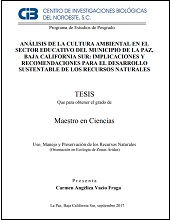| dc.contributor | ALFREDO ORTEGA RUBIO | |
| dc.creator | CARMEN ANGELICA VACIO FRAGA | |
| dc.date | 2017-09 | |
| dc.identifier | http://cibnor.repositorioinstitucional.mx/jspui/handle/1001/542 | |
| dc.identifier.uri | http://dspace.cibnor.mx:8080/handle/123456789/2668 | |
| dc.description | "La cultura ambiental indica la forma en que los individuos se relacionan con el medio ambiente a través de sus actitudes, comportamientos y conocimientos ambientales; ésta se transmite de generación en generación o a través de una educación ambiental sólida. Baja California Sur cuenta con ecosistemas aún en buen estado de conservación, no obstante la problemática ambiental va en aumento. La solución de estos problemas requiere de ciudadanos con formación adecuada para actuar frente a los mismos, sobre todo de los jóvenes por el importante rol que estarán en breve asumiendo en las actividades del estado; a pesar de ello la educación ambiental sigue sin considerarse una prioridad. El objetivo de la presente investigación fue analizar la cultura ambiental de estudiantes de nivel medio superior del Municipio de La Paz, Baja California Sur, y su implicación como herramienta para entender la educación ambiental en este sector educativo. Se aplicaron una serie de encuestas de cultura ambiental en 828 estudiantes, las cuales estaban conformadas por tres secciones: actitud, comportamiento y conocimiento ambiental; y posteriormente se utilizaron métodos cuantitativos para obtener los respectivos subíndices por cada sección, un índice de cultura ambiental (ICA) y el nivel de información sobre áreas naturales protegidas, así como métodos cualitativos para describir el entorno institucional en el que se desarrolla la educación ambiental formal. Los resultados indican que los estudiantes de La Paz poseen una cultura ambiental deficiente (x ̅=141.5, DS=20.9), principalmente en conocimientos (x ̅=64.0, DS=14.1) y comportamientos ambientales (x ̅=30.0, DS=9.0), esto contrasta con su buena actitud ambiental (x ̅=47.05, DS=6.6); así mismo mostraron un bajo nivel de información sobre las áreas naturales protegidas (x ̅=23.6, DS=7.24). No se encontraron diferencias significativas entre cultura ambiental, actitud, comportamiento y conocimiento en relación ni al género de los estudiantes, ni al tipo de institución y ubicación de la vivienda (p>0.05); pero sí se encontraron diferencias entre el comportamiento ambiental y el nivel socioeconómico de los estudiantes (K=7.578, p<0.05)..." | |
| dc.description | "Environmental culture is an indicator of the way that people are related to the environment through their attitudes, behaviors and environmental knowledge; it is transmitted from generation to generation or through a solid environmental education. Baja California Sur has ecosystems still in good state of conservation, however the environmental problems are increasing. The solution of these problems requires citizens with adequate attitude to address them, especially of young people for the important role that they will be assuming in the activities of the state; however, environmental education still is not a priority. The objective of this investigation was to analyze the environmental culture in high-school students from the Municipality of La Paz, Baja California Sur, and the environmental culture implication as a tool to understand environmental education in this educational sector. A series of environmental culture surveys were applied to 828 students, which were made up of three sections: Attitude, behavior and environmental knowledge; and then, quantitative methods were used to obtain an index for each section, an environmental culture index (ECI) and the level of information about natural protected areas, as well as qualitative methods to describe the institutional environment in which it is developed the formal environmental education. The results indicate that the students of La Paz have a poor environmental culture (x ̅=141.5, DS=20.9), mainly in knowledge (x ̅=64.0, DS=14.1) and environmental behaviors (x ̅=30.0, DS=9.0), this contrasts with their good environmental attitude (x ̅=47.05, DS=6.6); also they showed a low level of information about the natural protected areas (x ̅=23.6, DS=7.24). There were no significant differences in environmental culture, attitude, behavior and knowledge between the gender, the type of institution and the house location (p>0.05); but there were differences in environmental behavior and socioeconomic status (K=7.578, p<0.05)..." | |
| dc.format | application/pdf | |
| dc.language | spa | |
| dc.publisher | Centro de Investigaciones Biológicas del Noroeste, S.C. | |
| dc.rights | info:eu-repo/semantics/openAccess | |
| dc.rights | http://creativecommons.org/licenses/by-nc-nd/4.0 | |
| dc.subject | info:eu-repo/classification/AUTOR/Cultura ambiental, educación ambiental, índice de cultura ambiental, áreas naturales protegidas, bachillerato | |
| dc.subject | info:eu-repo/classification/AUTOR/Environmental culture, environmental education, environmental culture index, natural protected areas, high-school level | |
| dc.subject | info:eu-repo/classification/cti/6 | |
| dc.subject | info:eu-repo/classification/cti/31 | |
| dc.subject | info:eu-repo/classification/cti/3106 | |
| dc.subject | info:eu-repo/classification/cti/310601 | |
| dc.subject | info:eu-repo/classification/cti/310601 | |
| dc.title | Análisis de la cultura ambiental en el sector educativo del Municipio de La Paz, Baja California Sur: implicaciones y recomendaciones para el desarrollo sustentable de los recursos naturales | |
| dc.type | info:eu-repo/semantics/masterThesis | |
| dc.type | info:eu-repo/semantics/acceptedVersion | |


